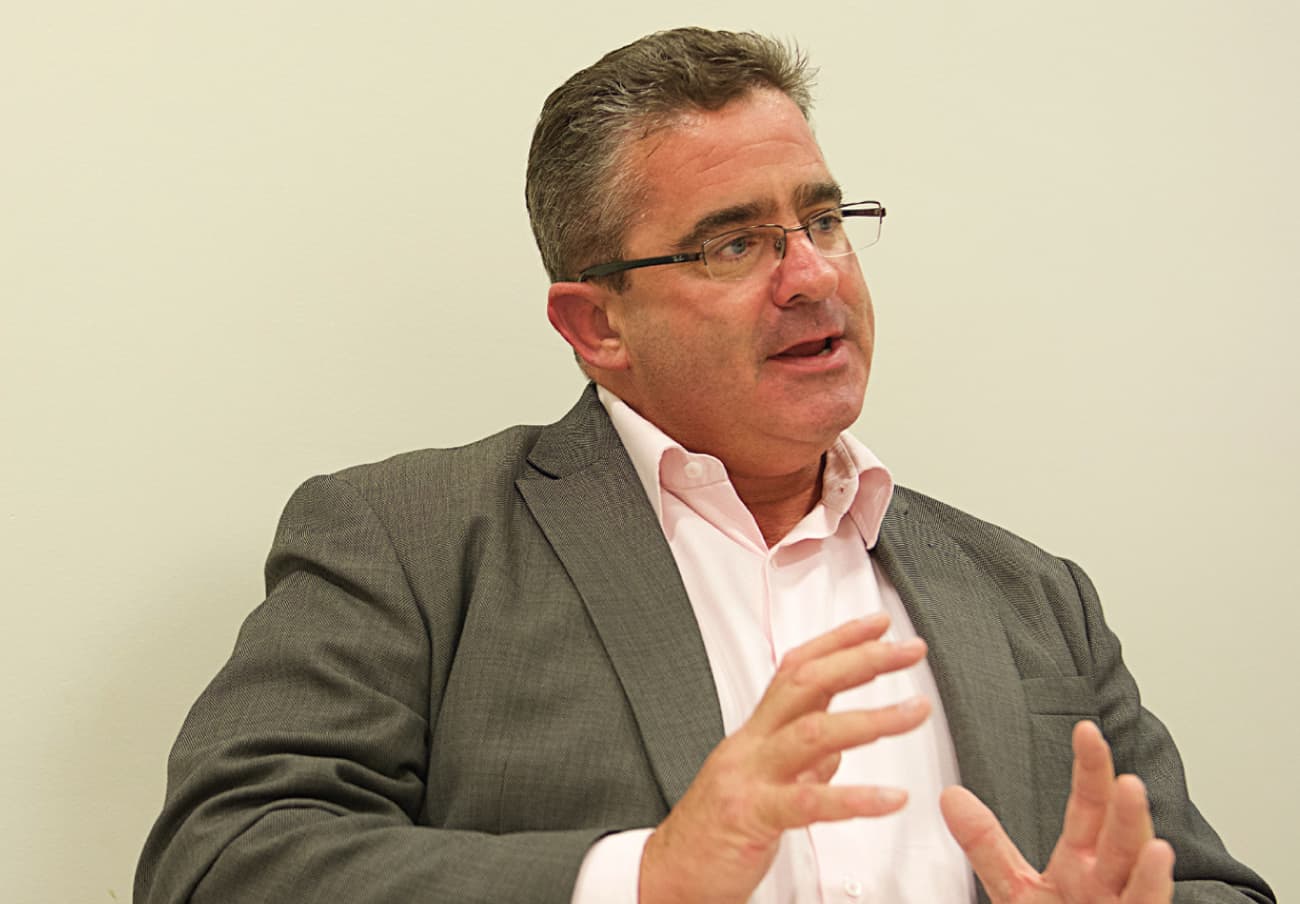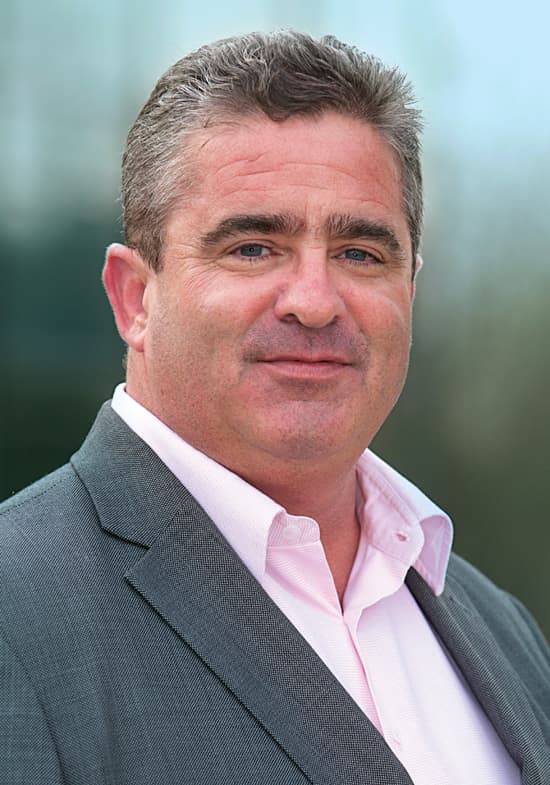Hard yards
5th July 2015 | Dr Philip Squire and Chris Alder
Head of sales for global snacks company Mondelez International, Andy Tosney talks about how simplification and standardisation of sales processes is transforming the organisation and delivering a powerful boost to company revenues.

Andy Tosney: “I learned by doing. I wasn’t on the graduate scheme so I had to prove I could do the job before I could be moved on.” © Sam Pearce, Square Image
Andy Tosney is passionate about what he does….
“I’ve never had a day in my life when I’ve woken up and not wanted to go to work. I used to get paid for playing rugby and work 6am till 6pm in a metal foundry with study in between…. That’s a tough way to make a living!
Now I can go sell things, meet interesting people, grow the businesses, get mutual partnerships, deliver outcomes, sell solutions – that’s not a job; that’s fun!”
But when asked to describe the journey that has brought him to where he is now, the former England international employs a wry rugby phrase. “Hard yards would be the way I would describe it,” he says.
Based in Dubai, Tosney is the sales component of the team responsible for the day-to-day running of Mondelez International’s 45,000-strong global sales operation.
Energetic
The former England rugby player is also energetic. “I’m up at 5.30am, in the gym by 6.15am for an hour, then in the office for 8am. My typical working day starts with an hour blocked out for emails, and preparation for meetings during the day. I will have a number of teleconferences with colleagues in Europe when they wake up at around 11am. By 3pm my time, America wakes up and my day goes on until 7-8pm depending on what’s happening.”
And there’s a lot happening. The snacks company, one of the world’s largest with global net revenues of $34 billion in 2014, was split from grocery giant Kraft with a single focus in mind: create delicious moments of joy by sharing the world’s favourite brands. Now Mondelez is taking the concept of simplicity and applying the model in the sales environment to transform its business.
Tosney says: “Mondelez is a multi-category organisation with many brands. Our model is to leverage the strength and power of our portfolio. Standardising our approach is a critical enabler so we can deal with the complexities and make things more simple.”
I’ve done nearly every job in sales from trainee rep to running a global organisation.
It’s clearly a mammoth task. The company operates in 162 countries, and employs around 107,000 people in five regions: North America and Canada; Latin America; Middle East Asia Pacific; and Europe. It makes some of the best-known snacks brands around the globe. Its 15 global ‘power brands’ – biscuits Oreo, Chips Ahoy!, TUC, belVita, Club Social and Barni; chocolate Milka, Lacta, Toblerone, and Cadbury Dairy Milk; and gum and candy Trident, Chiclets, Halls, Stride and Cadbury Dairy Milk Eclairs – are expected to drive 60 per cent of the company’s growth going forward.
Each region has a market president, in charge of the markets and sales organisation in the region; The regional presidents plus Tosney make up the global sales council.
Tosney says: “The new sales model is designed to build systemic capability and consistency across the organisation. Globally we have a centre of excellence. In the regions we have centres of deployment and locally we have centres of execution, so we have a mirror organisation all the way through our base capabilities. The centre of deployment, the region, works with the centre of excellence to define what is the standard process, the standard toolkit, the standard capability building we need, and what is our market loading – in other words, which market, regions and categories are we going to go for first to build that capability. When that process is done, the centre of deployment then goes to the markets and deploys that with a mirror team in the markets.
Global standard
“What’s really exciting is that we have managed, for the first time in our history, to have a standard sales organisation all over the world, with one way of working, one language, one toolkit, and a systemic capability right through the organisation. We are finding that building that global community is speeding up our results delivery, and also the capability to go forward with one way of doing things, reducing time, cost and complexity and giving us real competitive advantage.”

Andy Tosney. © Sam Pearce, Square Image
The son of a man who had his own building business, Tosney admits he was passionate about rugby, but not very interested in education. “Consequently I came out of school with mediocre results, but I signed the forms to be a professional rugby player at the age of 15 and started playing rugby league for a professional side in the north of England when I was 16. I was lucky enough to play for Great Britain on a couple of occasions.
“At that time clubs made you have an occupation and post-school education in case you got a long-term injury which happened quite frequently. I took an apprenticeship in mechanical engineering and studied at Leeds to get my qualifications.” He subsequently retired from professional rugby in the 1990s after a serious ankle injury.
“After I finished studying I wasn’t sure what to do. My brother was a sales rep for aluminium manufacturer Alcan and I used to look at him coming home in his smart suit and company car, and I’d be battered and bruised and working in a metal foundry. He had the better idea. He helped me prepare for an interview and I borrowed his suit and ended up working for Canon selling photocopiers. No base salary, commission only, but I was heavily trained in all aspects of selling. You went out and knocked on doors. Out of 1,000 cold calls you might get 50 meetings and out of those meetings you might get five demonstrations and perhaps one sale. It was hard work but great fun.
“But I was 20 and wanted to get married but the bank wouldn’t give me a mortgage on commission only so I was forced to look for a new job in selling. I’d got the bug for it and, if you could work hard and smile, you could get results. So I applied for a job with chocolates company Terry’s, which was then part of United Biscuits, but taken over by Kraft Foods in 1993. The Terry’s job was advertised in the local paper and there were 5,000 applicants. I got the job after three interviews and became a trainee sales rep in Leeds.
“I learned by doing. I wasn’t on the graduate scheme so I had to prove I could do the job before I could be moved on. I’ve done nearly every job in sales from trainee rep to running a global organisation. I was, at one time, the youngest area manager in United Biscuits – which I admit was quite daunting in the first few meetings, as the average age was around 50 and they were all top-class and experienced, and I was 23!”
I have found it interesting that salespeople see themselves as predominantly local. They think what they do in their market is the way it should be done.
Ironically he never really wanted to “go international”. “I was running sales at Wal-Mart in the UK and they asked me to go and run Wal-Mart globally. We had had a lot of success in the UK but I never really wanted to do a global role. However, there was no option. I managed to do the job from the UK and we doubled the size of the business to more than a billion dollars over the three years and we also managed to win the global supplier of the year for two years in succession. That was my first introduction to working internationally.”
Back in the present, he says recognising the power of sales to gain a competitive advantage for Mondelēz, based on the simple mantra “standardise, simplify, reduce cost and invest in growth” is just the first step. One of the key components of the transformation is the new sales enabler known as “Project Wise”, a significant investment in sales force technology.
“When sales reps are in store and seeing their customers there’s one process designed to make life easier and support the rep to do the perfect call; this means their call is much more efficient and also much more effective, ensuring that a rep does not miss any opportunity. We do that through technology which feeds back to a business intelligence system.

“It starts with the shopper. Traditionally we would segment trade in the old world as ‘traditional’ trade and ‘modern’ trade, but that’s not how the shopper sees it. We look at standardised shopper missions, such as the weekly shop, fortnightly stock-up or urgent snack. The mission determines the consumer store choice, which makes them predisposed to certain categories and brands. This holds remarkably similar whether it’s Europe, Japan, China or anywhere else. The trick is how to make the most of that in-store environment.
Consumer insight
“Take kiosks, an emergency destination stop. I’m in a hurry on my way to work. I need cigarettes, a paper, a snack; it’s no good trying to sell me a £20 box of chocolates. But if I see a small bar of wafer chocolate to go with the coffee when I get to work, I’ll take it. It’s about getting the most stock turn out of each store by getting the right portfolio in place, and making sure it’s in the right position to be in arm’s reach of being bought. That’s what gives us a perfect store picture of success for that retail environment, which exhibits the right pricing, promotion, position, and merchandising equipment. We can do that for every brand, for every store. Instead of the rep selling customers what he thinks they want, we are selling based on shopper and consumer insight.”
And the sales strategy goes further: “The the way the rep actually makes the call, with its six steps, is fixed into the system and available via a tablet or handheld, guiding him or her through the call to make it perfect. The rep sees who the shop owner is, what the must-sell list is, what was missing last time, and more. All that data is collected so we know how close to perfect that store is, as well as the full potential of the store.
Tosney’s top tips
…for sales people
- Be clear that you enjoy what you do and be passionate about it.
- Have an inquisitive mind.
- Love and be interested in people no matter what you are selling, and have mutual interests at heart.
…for sales management
- Love people and love being part of a team.
- Have self discipline – do what you say you’re going to do.
- Set stretching targets and celebrate achievement.
“The Wise system is standardised across the world. We will be in 34 markets by the end of this year, and in 80 markets by the end of 2017. When we are deciding what to make, and what we should be selling, we look at the perfect store data. It also means we have just one set of training material for all our reps around the world. As you learn your job at different levels in the organisation, the process is the same because it’s standardised and systematised. Everyone talks the same language, knows what the gaps and opportunities are. It goes like clockwork.”
He admits there was “just a bit” of internal resistance to the changes, but he says the right people are now in the right positions. The backing of chairman and CEO Irene Rosenfeld and her management team was also key.
Local heroes
“I have found it interesting that salespeople see themselves as predominantly local. They think what they do in their market is the way it should be done. Actually, as you work across different markets, you realise there are more similarities than differences. If you look at category management, for example, the process is the same anywhere in the world. Your data and the insights that come out maybe are different because the consumer is different, but the way you organise the process for doing it is all the same.
“I’ve found that yes, there are cultural differences and sensitivities, but people have all got goals to achieve, different emotions; really, the cultural interface is just one more layer but smart people with a passion to learn and ask questions are the important ingredient. I’m not saying it’s easy. People are complex and, if you want to influence them, you have to pick up on the vibe, listen with the intent to understand their needs, watch the body language to understand the mood, and know what you want the outcome to be, and to be able to close a sale in a way that’s mutually beneficial. Over time you build trust, and that trust builds into a great relationship that can bring wonderful business results.”


